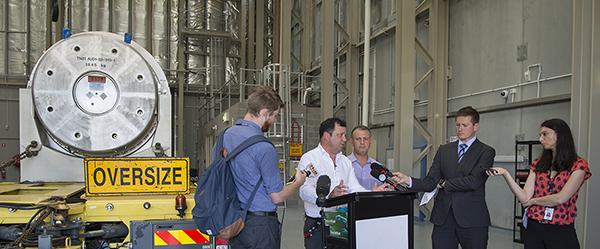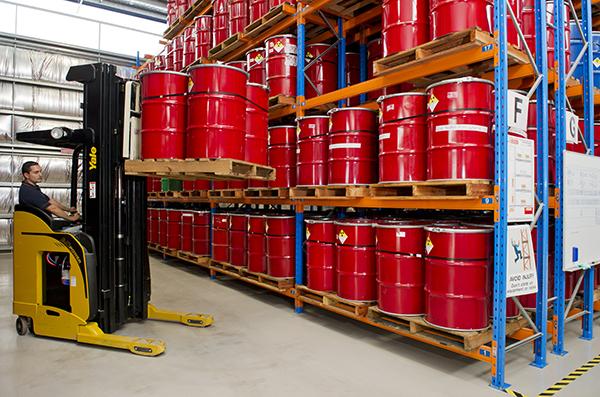

Published on the 16th July 2021 by ANSTO Staff
The world has more than half a century of knowledge and experience on how to deal with nuclear waste. When the characteristics of the waste are known, it can be managed safely. — Getting to the Core of Nuclear Waste IAEA
The use of radioactive materials and radiation at the OPAL multipurpose reactor provides numerous benefits to Australia and underpins the modern health care system on which we all rely.
The reactor supports the production of nuclear medicine that every Australian is likely to benefit from at some point in their lifetime and also has a range of other scientific research and industrial applications. One of the by-products of these benefits is a relatively modest amount of radioactive waste.
“Not all radioactive waste is the same, and different forms of radioactive waste with different levels of radioactivity are managed differently. Most is solid but some is liquid. Some waste is stored until its radioactivity has decayed and is then transferred to municipal waste facilities, while other waste needs to be managed over much longer periods of time in specialised facilities,“ said Chief Nuclear Officer, Hefin Griffiths.

Hef Griffiths takes questions from the media in 2015 when the canister arrived at Lucas Heights
“We know the type of waste, its contents, its level of radioactivity and how long it will be radioactive, so we know exactly what we have to do to keep our environment and everyone safe,” he added.
“Just because you can’t see radiation, does not mean you can’t manage the risk it presents. In fact, we can measure it very precisely, and know exactly how long it will need management.”
Containing the waste securely, monitoring the radioactivity and isolating appropriately as needed, are standard practices around the world, which serve to keep radiation workers safe,” said Griffiths.
Well-established protocols, standards and practices, which are set by the Australian Radiation Protection and Nuclear Safety Agency (ARPANSA) in line with internationally accepted standards set by the International Atomic Energy Agency (IAEA), are the backbone of how ANSTO and Australia safely manage radioactive waste.
The extent of measures, such as shielding, is proportional to the level of radioactivity, and the length of time the waste will remain radioactive.
Radioactivity gradually diminishes as radioactive elements decay into more stable elements, so waste gradually becomes less radioactive and safer to handle over time.
Some waste is safe to stand near with no special personal protective equipment from the outset, but some requires significant shielding so that this is possible.
Every container of nuclear waste is labelled with the level of radioactivity it emits and other important information.
Waste generated from the operation of Australia’s nuclear reactor can be classified as low level, or intermediate level, which indicates the radioactivity levels and the time it takes to lose its radioactivity. Overseas reactors such as power reactors, also produce high-level waste. There is no high-level waste in Australia.
Low level waste
Low-level waste emits radiation at levels that generally require minimal shielding during handling, transport and storage.
Approximately 90 per cent of the radioactive waste produced by ANSTO is low-level waste, made up of paper, plastic, gloves, cloths and filters which contain small amounts of radioactivity for a number of years. This waste is from the operations of OPAL, scientific experiments and the manufacturing and processing of nuclear medicines.

Low level waste storage at ANSTO
This waste is shredded and compressed into 200 litre red drums, which are currently stored safely at ANSTO. There are currently two storage facilities holding this waste at ANSTO, one of which has already reached capacity. Eventually, this waste will be transported to Australia’s National Radioactive Waste Management Facility once it is established towards the end of this decade.
The radioactivity is monitored regularly using a scanning system. The drums are bar-coded and the radioactive content of each drum is entered into a database to ensure that the waste is safely, securely and efficiently managed in compliance with the standards set by the IAEA and ARPANSA.
Intermediate-level waste
Intermediate level waste emits higher levels of radiation and requires additional shielding before it can be handled, transported or stored. In some cases, intermediate-level radioactive waste can be converted into a safer, more manageable form by conditioning or treatment.
The OPAL reactor operates using a core of 16 uranium fuel rods. When these are used, they are grouped together and periodically sent overseas for reprocessing.
Reprocessing is the process of extracting the remaining uranium (and the small amounts of plutonium generated during the fuel’s use in the reactor) which are then used to manufacture fuel for overseas civil power reactors. Reprocessing also minimises long-lived radioactive materials and immobilises them so that they are suitable for permanent storage.
The resulting waste is eventually transported back to Australia. That resulting waste is classified as intermediate-level waste, because it has within it, radioactive components that emit higher levels of heat or energy, which decay over a much longer period than low-level waste.
According to an international convention, all countries which produce radioactive waste must take responsibility for the safe management and storage of that waste.
In line with that agreement, a shielded TN-81 canister which is made of forged steel with walls more than 20 cm thick, was returned to ANSTO in 2015 with the reprocessed waste.
This single canister contained the intermediate level waste generated from much of the 50 years that the HIFAR research reactor operated in Lucas Heights.
The radiological material inside the canister is equivalent to 1288 spent fuel rods that were sent to France for reprocessing over four shipments between 1999 and 2004. The return of waste from the UK in 2020 will contain the equivalent amount of residual radioactive material from the processing of just 114 spent fuel elements.
Just like the operation of a nuclear reactor, the transport of nuclear materials including is a highly regulated undertaking, supported by a collective of government and emergency service authorities.
Transporting nuclear materials safely takes place around the world every day. According to the World Nuclear Association, about 20 million consignments of radioactive material are transported each year.
In Australia, the transport of radioactive material must meet ARPANSA’s Australian Code of Practice for the Safe Transport of Radioactive Material, which is based on IAEA regulations
When the first container was repatriated in 2015, ANSTO held a press conference next to the canister that contained the reprocessed nuclear fuel.
“The media and I stood right next to the canister during the press conference. It is so heavily shielded that you can’t actually detect radiation levels when right next to it,” said Griffiths.
Much of ANSTO’s confidence in the safe management of its nuclear waste comes from a highly trained workforce of 50 people with over 500 years of experience between them, who manage waste operations on site and provide and provide professional services to other organisations.
“With all the benefits that the use of radiation and radioactive material can bring, we need to ensure we safely and appropriately manage the by-products from these benefits. ANSTO will continue to support our wider Australian community to ensure this is done, drawing from over half a century of knowledge and with vigilance, dedication and confidence,” said Griffiths.